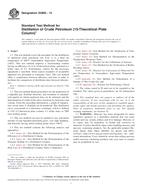Potrebujeme váš súhlas na využitie jednotlivých dát, aby sa vám okrem iného mohli ukazovať informácie týkajúce sa vašich záujmov. Súhlas udelíte kliknutím na tlačidlo „OK“.
ASTM D2892-13
Standard Test Method for Distillation of Crude Petroleum (15-Theoretical Plate Column)
Automaticky preložený názov:
Štandardná skúšobná metóda pre destiláciou ropy (15-teoretické Plate Column)
NORMA vydaná dňa 1.5.2013
Informácie o norme:
Označenie normy: ASTM D2892-13
Poznámka: NEPLATNÁ
Dátum vydania normy: 1.5.2013
Kód tovaru: NS-21873
Počet strán: 34
Približná hmotnosť: 102 g (0.22 libier)
Krajina: Americká technická norma
Kategória: Technické normy ASTM
Anotácia textu normy ASTM D2892-13 :
Keywords:
boiling point distillation, crude oil distillation, distillation, fractional distillation, TBP curves, ICS Number Code 75.040 (Crude petroleum)
Doplňujúce informácie
| Significance and Use | ||||||||||||||||||||||||||||
|
5.1 This test method is one of a number of tests conducted on a crude oil to determine its value. It provides an estimate of the yields of fractions of various boiling ranges and is therefore valuable in technical discussions of a commercial nature. 5.2 This test method corresponds to the standard laboratory distillation efficiency referred to as 15/5. The fractions produced can be analyzed as produced or combined to produce samples for analytical studies, engineering, and product quality evaluations. The preparation and evaluation of such blends is not part of this test method. 5.3 This test method can be used as an analytical tool for examination of other petroleum mixtures with the exception of LPG, very light naphthas, and mixtures with initial boiling points above 400°C. |
||||||||||||||||||||||||||||
| 1. Scope | ||||||||||||||||||||||||||||
|
1.1 This test method covers the procedure for the distillation of stabilized crude petroleum (see Note 1) to a final cut temperature of 400°C Atmospheric Equivalent Temperature (AET). This test method employs a fractionating column having an efficiency of 14 to 18 theoretical plates operated at a reflux ratio of 5:1. Performance criteria for the necessary equipment is specified. Some typical examples of acceptable apparatus are presented in schematic form. This test method offers a compromise between efficiency and time in order to facilitate the comparison of distillation data between laboratories. 1.2 This test method details
procedures for the production of a liquefied gas, distillate
fractions, and residuum of standardized quality on which analytical
data can be obtained, and the determination of yields of the above
fractions by both mass and volume. From the preceding information,
a graph of temperature versus mass % distilled can be produced.
This distillation curve corresponds to a laboratory technique,
which is defined at 15/5 (15 theoretical plate column, 5:1 reflux
ratio) or TBP (true boiling point).
1.3 This test method can also be applied to any petroleum mixture except liquefied petroleum gases, very light naphthas, and fractions having initial boiling points above 400°C. 1.4 This test method contains the following annexes and appendixes: 1.4.1 Annex A1—Test Method for the Determination of the Efficiency of a Distillation Column, 1.4.2 Annex A2—Test Method for the Determination of the Dynamic Holdup of a Distillation Column, 1.4.3 Annex A3—Test Method for the Determination of the Heat Loss in a Distillation Column (Static Conditions), 1.4.4 Annex A4—Test Method for the Verification of Temperature Sensor Location, 1.4.5 Annex A5—Test Method for Determination of the Temperature Response Time, 1.4.6 Annex A6—Practice for the Calibration of Sensors, 1.4.7 Annex A7—Test Method for the Verification of Reflux Dividing Valves, 1.4.8 Annex A8—Practice for Conversion of Observed Vapor Temperature to Atmospheric Equivalent Temperature (AET), 1.4.9 Appendix X1—Test Method for Dehydration of a Sample of Wet Crude Oil, and 1.4.10 Appendix X2—Practice for Performance Check. 1.5 The values stated in SI units are to be regarded as the standard. The values given in parentheses are for information only. 1.6 This standard does not purport to address all of the safety concerns, if any, associated with its use. It is the responsibility of the user of this standard to establish appropriate safety and health practices and determine the applicability of regulatory limitations prior to use. 1.7 WARNING—Mercury has been designated by many regulatory agencies as a hazardous material that can cause central nervous system, kidney and liver damage. Mercury, or its vapor, may be hazardous to health and corrosive to materials. Caution should be taken when handling mercury and mercury containing products. See the applicable product Material Safety Data Sheet (MSDS) for details and EPA’s website—http://www.epa.gov/mercury/faq.htm—for additional information. Users should be aware that selling mercury and/or mercury containing products into your state or country may be prohibited by law. |
||||||||||||||||||||||||||||
| 2. Referenced Documents | ||||||||||||||||||||||||||||
|
Odporúčame:
Aktualizácia technických noriem
Chcete mať istotu, že používate len platné technické normy?
Ponúkame Vám riešenie, ktoré Vám zaistí mesačný prehľad o aktuálnosti noriem, ktoré používate.
Chcete vedieť viac informácií ? Pozrite sa na túto stránku.




 Cookies
Cookies
